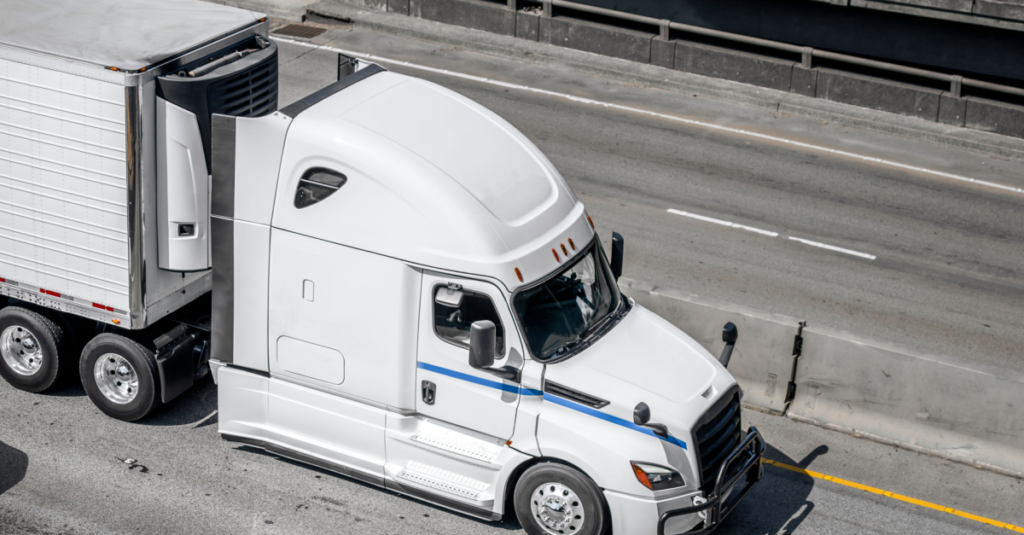When the Covid-19 pandemic started, one common image was of empty store shelves at the supermarket. A common industry refrain related how Americans were seeing the role of truck transportation in their lives. According to the Census Bureau’s Commodity Flow Survey, nearly $900 billion worth of food moved via truck transportation in 2017 (the latest data available). Within that category, 129 million tons of food products were moved using temperature controlled trucks.
Although climate controlled shipping is responsible for nearly every product on the grocery store shelf, refrigerated trucks move a lot more than food. Each day, they transport pharmaceuticals, electronics, hazardous materials, and even live animals. Controlled temperature transport is an essential part of the economy, but managing it can cause more than a few headaches. Read on to learn how temperature controlled shipping works, what its biggest challenges are, and what you can do to overcome those obstacles.
What Is Temperature-Controlled or Climate-Controlled Freight?
The terms “temperature-controlled freight” and “climate-controlled freight” both refer to the transportation of temperature-sensitive goods. During temperature-controlled shipping, items must be kept within a specific thermal range for their entire journey. Storage, handling, and transportation must all meet specific temperature-related storage and shipping requirements.
When is Temperature-Controlled Shipping Needed?
Temperature-controlled shipping is a non-negotiable for any item that could spoil or become unsafe outside of a specific thermal range. A few examples that might come to mind are produce, meat products or certain medications – products that must be kept cold. But there are other temperature-sensitive items that may be less intuitive. We’ll list a few below:
Common Types of Temperature Controlled Freight
Food – Fresh fruits and vegetables, meats, dairy products, herbs and flowers can spoil if overheated.
Confectionary Products – Baked goods, candy, or raw materials like sugar and chocolate can melt or have their chemical composition otherwise altered.
Health and Beauty Supplies – The wrong temperature can denature enzymes in foundation, concealer, shampoo, conditioner, or fragrances.
Nutritional Supplements – Vitamins, shakes, snacks, and syrups can spoil if their temperature gets too hot or too cold.
Frozen Foods – Microwave dinners, frozen meats, and ready-to-prepare foods can turn rancid once they thaw.
Medicines and Pharmaceuticals – Pills, vaccines, lab kits, test products, and even certain equipment are extremely sensitive, and can become dangerous outside of their storage temperature, even after a few minutes.
Live Animals – Livestock, poultry, pets, exotics, and even insects will die outside of a specific temperature range.
Artwork – Temperature and humidity changes can cause artwork to swell, contract, crack, or otherwise distort.
Electronics – Electronic components can fry, or freeze, if stored outside of a specific range.
Top Challenges in Temperature or Climate Controlled Shipping
Inadequate Documentation – An inadequate paper trail can cause two problems in cold chain shipping. First, improper records raise the chance of freight being stored at the wrong temperature and getting damaged or spoiled. Second, compliance violations can lead to hefty fines from the USDA, or international oversight organizations if importing and exporting.
Delays and Disruptions Add to Risk of Damages – Reefer equipment breaks down. Traffic can pick up unexpectedly. Even unexpected weather can slow a product’s transit time. The challenge is to maintain temperature when these incidents happen. Perishable commodities must have the correct temperature or the shipper and carrier risk product rejection at the receiver.
Changing Global Regulations – Each state or country is going to have its own set of temperature sensitive shipping regulations, and trying to meet them all can be difficult. Differences in regulations raise the odds of freight being seized and exposed to ambient temperatures.
Limited Refrigerated Units and Tight Capacity – Refrigerated units “reefers” have limited internal capacity in the truckdue to their insulated walls. The biggest problem facing shippers is securing reefer capacity during produce season, as carriers chase lucrative shipping lanes near the Mexico borderlands, Florida, and Washington.
Refrigeration Unit Problems – Power outages, a lack of uniform standards, even dealing with different power outlet designs can make for a bad day in temperature-sensitive shipping.
Issues with Temperature-Controlled Docking Facilities – Depending on the product, the temperature variance window can be quite small. Even mishandling during loading or unloading can compromise a temperature sensitive item.
Packaging Issues That Put Items at Risk of Damages – Every shipment must be packaged according to its particular temperature requirements. If it isn’t packed for the expected travel time, it can incur damage en route.
Regulations Around Temp-Controlled Shipping
In the United States, the FDA and the CDC issue guidelines to carriers, such as the Food Safety Modernization Act or Guidelines For Maintaining and Managing the Vaccine Cold Chain. Title 21 of the Code of Federal Regulations also concerns cold chain safety.
Outside of the United States, shippers should be aware of requirements set by the Canadian Food and Drugs Act, the European Commission Guidelines on Good Distribution Practice of Medicinal Products For Human Use, and regulations set by the World Health Organization.
How Much Does Temperature Controlled Shipping Cost?
Temperature controlled shipping costs can vary based on climate, fuel costs, and the size, weight, and temperature needs of your product. One thing that’s for certain is that refrigerated shipping will cost more than moving other freight. This is because refrigerated trucks require more energy to maintain their temperature range and operate on a tight schedule to prevent accidental thawing. Here we’ll discuss a few ways to manage shipping costs:Tips and Best Practices For Temperature-Controlled or Climate-Controlled Freight Shipping
Factors to Consider:
Temperature and Timing – This includes your cargo’s temperature range, transit window, and whether you are measuring in Fahrenheit or Celsius.
Packaging – There are a variety of materials available to insulate your freight – dry ice, gel coolants, foils, blankets, and foams. Some of them are considered hazardous, so be sure to talk to your carrier about handling requirements.
Cargo Weight and Size – As we mentioned earlier, controlled temperature transport has less space and payload capacity. You’ll want to keep an eye on the dimensions of your freight to avoid any surprises.
Avoid Refrigerated Shipping Mistakes Proactively
Talk To Your Providers Ahead of Time, and Be Clear About Your Temperature Requirements – Frozen fish, flowers, and dairy products each have different temperature requirements. The same goes for varying pharmaceutical products. Carriers need to know what products they are shipping, what temperature they need to stay at, and for how long.
Include a Temperature Monitor With Your Shipment – Having a constant read on the status and temperature of your shipments can help you catch a temperature excursion as it’s happening, not after your product has already arrived damaged at its destination.
Request an Electronic Log of Trailer Temperatures For the Shipment – Electronic logs tell all parties what temperature goods were at, and for how long. It won’t save you from an order that’s already been damaged, but it could help you identify future patterns or problem areas.
Partner With a 3PL Who Has Experience In Temperature-Controlled Logistics – Handling temperature-sensitive shipping in-house can be a tall order. Another option is to outsource climate control trucking to a third party who deals in climate control transportation.
How to Overcome Facilities Problems
Communication – Talk to your transportation provider and find out the conditions at their docking facility, and come up with a plan to prevent a temperature excursion during loading or unloading.
Packaging Properly – Improper packaging is a huge cause of temperature excursions. Make sure you’ve got plenty of insulation, and consider using thermal blankets at docking facilities to protect your freight.
Securing Capacity Tips
Know Your Shipments – What types of cold-storage products do you ship, and how often? Do they need to be frozen, refrigerated, or even kept warm? These considerations will help you decide what volume of capacity you will need.
Shipping Costs – Refrigerated shipping requires more fuel, especially in warmer months and climates. There are also additional packaging requirements, and less space and payload capacity within each truck. Given the needs of cold storage products, it’s best not to cut corners here.
Analyze Your Supply Chain – Electronic logs and temperature monitors can help you to identify problem areas within your supply chain, including unmet temperature sensitive shipping needs. Look for patterns in your shipping history, and come up with a plan to address or work around them.
Avoid Sourcing Capacity On Your Own – Refrigerated capacity is often in high demand, especially during produce season, the holidays, and the summer months. To get ahead of the crowd, consider working with a 3PL who has established relationships with carriers and can help secure capacity early.
FAQ
How many pallets fit in a refrigerator truck?
Typically a refrigerated truck has the capacity to carry up to 30 pallets, depending how it’s loaded and the product weight.
At What Temperature is the Cold Chain Broken?
The cold chain is considered broken when the temperature of the cargo exceeds the range needed to preserve the product. This causes products to spoil or incur damage.
How Does a Refrigerator Truck Work?
Refrigerated trucks have a built in refrigerator or freezer that isolates cargo from external temperatures.
What is the Cold Chain?
The term cold chain refers to the system needed to maintain products at a specific temperature during transportation.
How is the Cold Chain Broken?
The cold chain has broken if a product’s temperature crosses outside of the required range. This can happen in almost any part of the transportation process. If an order preparation time is slow, or if there’s inadequate packaging or a shipping delay, or if a warehouse isn’t properly refrigerated, these factors can cause temperature excursions which can damage the product.
How to Detect if the Cold Chain Has Been Broken During Transport?
The best way to detect breaks in the cold chain is to install a temperature recorder that can monitor temperatures throughout the supply chain. That way, the shippers can create a data trail that protects them in the event of a temperature excursion, and potentially notify the carrier when a problem occurs.
If This is the Conclusion then we need to title the Conclusion
Temperature sensitive shipping can be challenging, risky, and expensive . Demand for these services is high, and it adds another layer of planning on top of the usual shipping considerations. In spite of this, no shipper can afford to neglect their climate control transportation if they provide temperature-sensitive products. Instead, shippers face a choice: manage all the booking, packaging, and temperature-monitoring that accompanies cold chain custody in-house? Or outsource climate-controlled operations to a logistics expert who will handle it for them?
If you need to take temperature-controlled freight management off your plate, consider partnering with an industry leader. AMX Logistics draws from an extensive network of qualified carriers, provides up to the second real-time tracking, and brings a 95% on-time rate to the table. Contact AMX Logistics today to learn how we can meet your cold chain needs.


